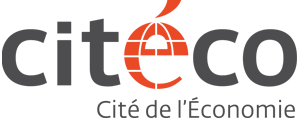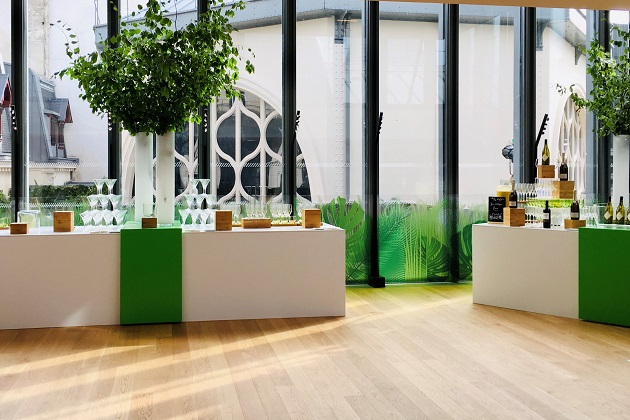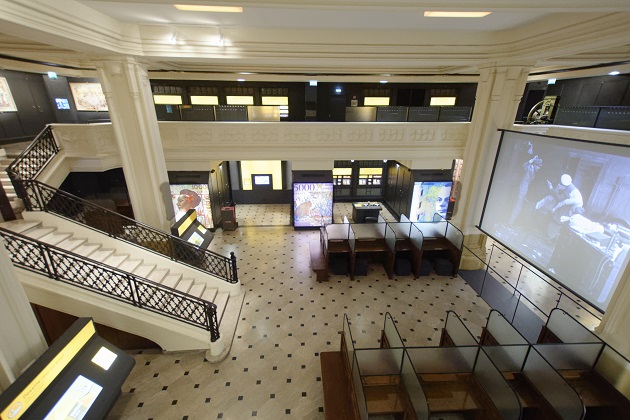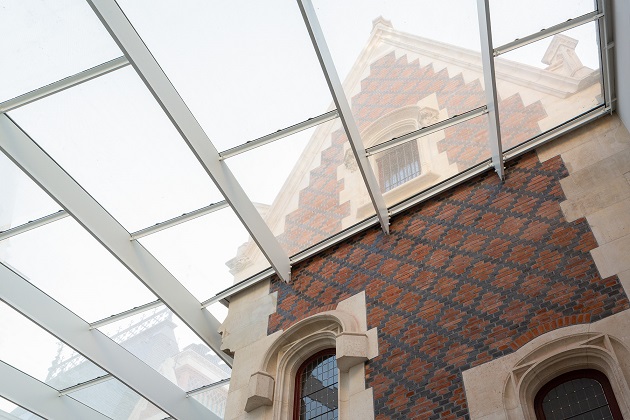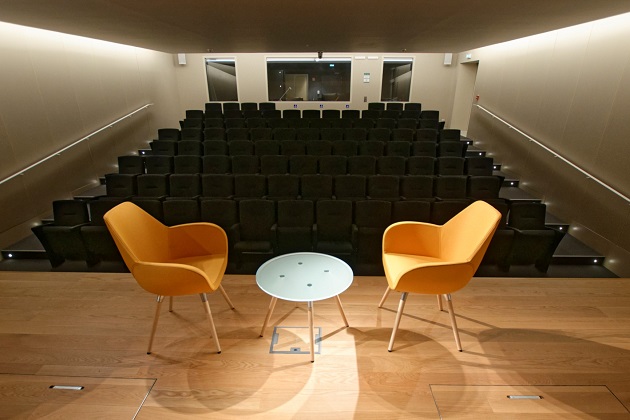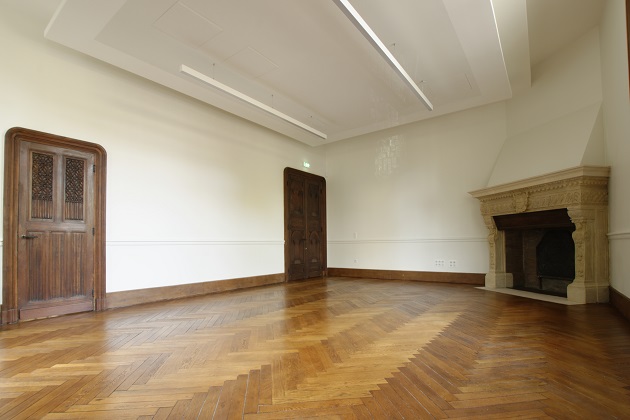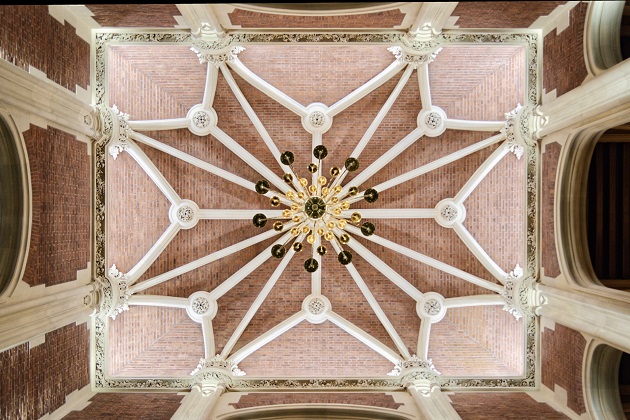A magical universe, combining history and modernity
Is your company looking to organise a memorable event? The Cité de l’Économie is full of gems and areas capable of hosting prestigious events
The Cité de l’Économie is housed by a jewel of Renaissance Revival architecture built in 1882, Hôtel Gaillard in Paris’ 17th arrondissement. This exceptional setting, which is classed a Historical Monument, is the product of a remarkable history marked by three main periods: from a town mansion belonging to banker Émile Gaillard, it was transformed into one of the Banque de France’s most beautiful bank branches before being entirely rehabilitated and turned into the first European museum dedicated to understanding main economic mechanisms.
Take a dizzying journey through the most beautiful periods and artistic styles!
|
160 people in a cocktail reception format On the 3rd floor, this room styled with contemporary elegance flirts with the sublime heights of Hôtel Gaillard |
100 personnes en format cocktail At the heart of Citéco’s numismatic collection, this impenetrable fortress spread over two levels hides many a treasure |
|
100 people in a cocktail reception format This old courtyard and its turret is complemented by a modern skylight offering a beautiful source of light |
95 seated people Our fully equipped auditorium will enable you to organize conferences or round tables |
|
Historical or modern conference rooms, to be used in combination with the auditorium for example. |
Private tours and Serious games During your private event, discover our museum and take part in its exceptional activities. |
Contact us at location@citeco.fr
Published on 10 July 2019. Updated on 10 November 2022
With this first major exhibition devoted to Largo Winch, the humanist billionaire, visitors of all ages will be given the chance to witness the great talent of the authors, discover the makings of a bestseller, and delve into the breathtaking adventures of our hero. Created by Citéco, Europe’s first ever museum devoted to economics, the exhibition also invites visitors to wander into the history of economy over the past 30 years in an entertaining and educative way.
Topics
 Comics art
Comics art
 Largo Winch’s universe & adventures
Largo Winch’s universe & adventures
 Economy & contemporary history
Economy & contemporary history
Availability
Starting from 2022.
Introduction
With an exceptional original collection of more than 60 original artworks, manuscripts, artefacts, reproductions, videos and sets, the exhibition is designed to give visitors of all ages a chance to venture into the art of comics and the makings of a bestseller, exploring the creativity of the saga artists.
A curated journey through the 22 albums enables to (re)discover the fascinating realm and quests of the hero who, at just 26 years of age, inherits a vast industrial and financial empire. Transported into a world of comics, visitors meet with the hero, his team, his friends and his enemies, and discover the extraordinary cityscapes that populate the series landscapes along the hero’s adventures, from Istanbul to Chicago, London to Hong Kong, Amsterdam to Venice.
Created by Citéco, Europe’s first ever museum devoted to economics, the exhibition also provides a highly original insight into the mysterious workings of contemporary economy, telling a story of 30 years of economy practices, major changes and challenges that have taken place since the first album of the series was published back in 1990. Visitors can grasp the basics of economics and delve into significant global economy concepts and events, from stock market crashes and subprime crisis to large-scale corruption, through the humanist billionaire’s adventures and the discovery of a very unique artistic creation.
A word from the curator
Didier Pasamonik, a renowned comic book specialist, journalist, bookseller, writer, and publisher who has more than forty years of experience in the comic book industry tells us a bit more about the exhibition.
The exhibition in the press
“The exhibition structured around this iconic comics character […] is certainly worth the trip. Thanks to its richness […], the educational aspects of the different themes addressed, but above all thanks to the elegance of its scenography.” Le Figaro
 “We get into economy without committing a crime.” Télérama
“We get into economy without committing a crime.” Télérama
“The meeting of Largo Winch […] and Citéco gives rise to an explosive cocktail in this original exhibition.” Art in the City
Contact Us
For more information on this touring exhibition, please leave us a message at export@citeco.fr or give us a call on the following number: +33 (0)6 13 42 87 35.
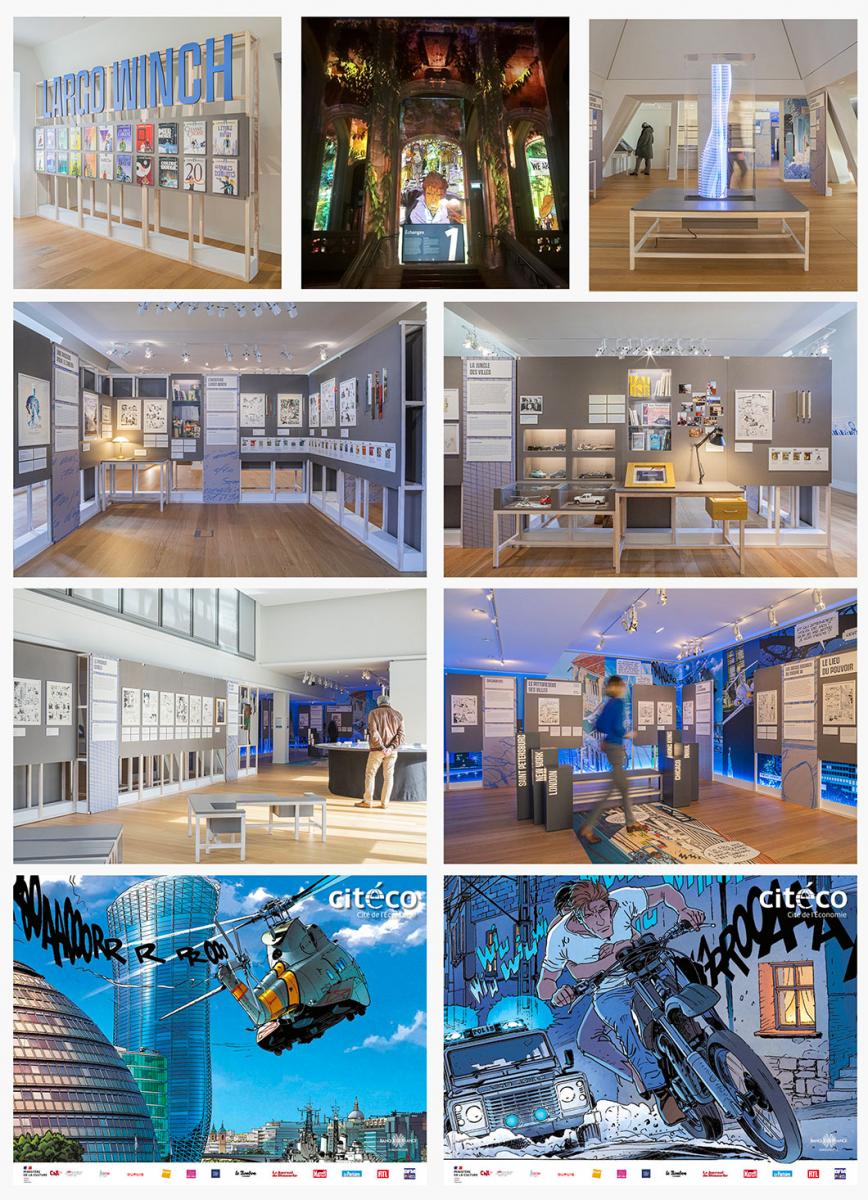
Published on 28 July 2021. Updated on 08 October 2021
To celebrate the 30th anniversary of the famous comic book saga written by Jean Van Hamme and illustrated by Philippe Francq (published by Dupuis), Citéco was initially scheduled to host from 17 October 2020 to 10 February 2021 an exceptional temporary exhibition specially designed for the museum, “Largo Winch, economic pathfinder”, which explores the links between the humanist multibillionaire and the key themes shaping the economy.
USEFUL INFORMATION
The Largo Winch exhibition will reopen on Saturday 29 May and last until 31 December 2021!
Dive into the universe of finance with the famous comic strip hero: Largo Winch, the billionaire playboy. Take this opportunity to decipher the inner workings of capitalism, financial markets and stock exchanges during an unmissable best-seller exhibition!
Open Tuesday to Sunday from 2 pm to 6 pm, open until 7 pm on Saturday.
This ticket does not include access to the permanent exhibition. If you wish to continue your Citéco visit, please book by adding another ticket to your basket!
EXHIBITION LAYOUT
The quality of the Largo Winch series stems first and foremost from its fast-paced, straightforward plots with punchy dialogue that enables us to easily grasp the basics of economics, as well as a touch of humour, thanks to finely honed, perfectly captured characters who evolve in stories shot through with a hint of social satire. Largo Winch above all reveals that managing an empire like the W Group is a thrilling and rewarding adventure with twists galore, as well as a whole host of opportunities for sharing one’s values and enthusiasm.
In the first room, visitors will find out more about the authors behind this enthralling saga; the second introduces us to Largo Winch and the people around him – friends and enemies alike; the third unveils the main cities his adventures bring him to and, last but not least, the fourth delves into how, in the thirty years since the first album was released, economics has been impacted by the myriad social and technological changes and upheavals, and how this is conveyed in the 22 albums relating the humanist billionaire’s adventures.
VIRTUAL VISIT
Virtually (re)discover our temporary exhibition on Largo Winch! In three videos, Éric Giacometti, Largo Winch scriptwriter, Didier Pasamonik, the exhibition’s curator, and Olivier Bossard, economy professor at HEC give you a behind-the-scenes peek at the comic strip and “Largo Winch: Economic Pathfinder”.
The origin of the work, the structure of the exhibition... Didier Pasamonik, the curator of “Largo Winch: Economic Pathfinder”, sheds some light on the series and gives you the inside story on the Citéco exhibition.
There is not one Largo Winch adventure that doesn’t address the issues of our contemporary economy! Olivier Bossard, economy professor at HEC, helps you to decipher the economic terms used throughout the series.
Why is Largo Winch so popular? Éric Giacometti, the series’ script writer since the 21st volume, looks back on the uniqueness of the legendary hero’s adventures in the third and last part of our virtual visit.
THE WINCH GROUP
The Winch group is a tentacular conglomerate. With a presence in 129 countries, it is comprised of a thousand of independent companies operating in eleven sectors from oil to banking, including aeronautics, mass distribution, the media or the hotel business.
In thirty years, with its acquisitions and investments, its workforce has increased from 400,000 to over 600,000 and its turnover has risen from 43 billion dollars to over 260 billion dollars. Furthermore, with total assets of over 740 billion dollars, it is now one of the 10 largest global groups, surpassing companies such as Amazon, Apple, Microsoft, Total or Toyota due to the size of its assets.
Yet, despite the Winch Group’s impressive growth, its profitability is not as extraordinary, particularly because most of its companies operate in traditional sectors or on mature markets with a high level of competitiveness. In addition, as the humanist billionaire that Largo is, maximum profit is not a priority. He prefers an ethical, societal and responsible approach to capitalism.
Source Forbes
Real Group Winch figures (Olivier Bossard and Pascal Quiry, professors of finance at HEC Paris):
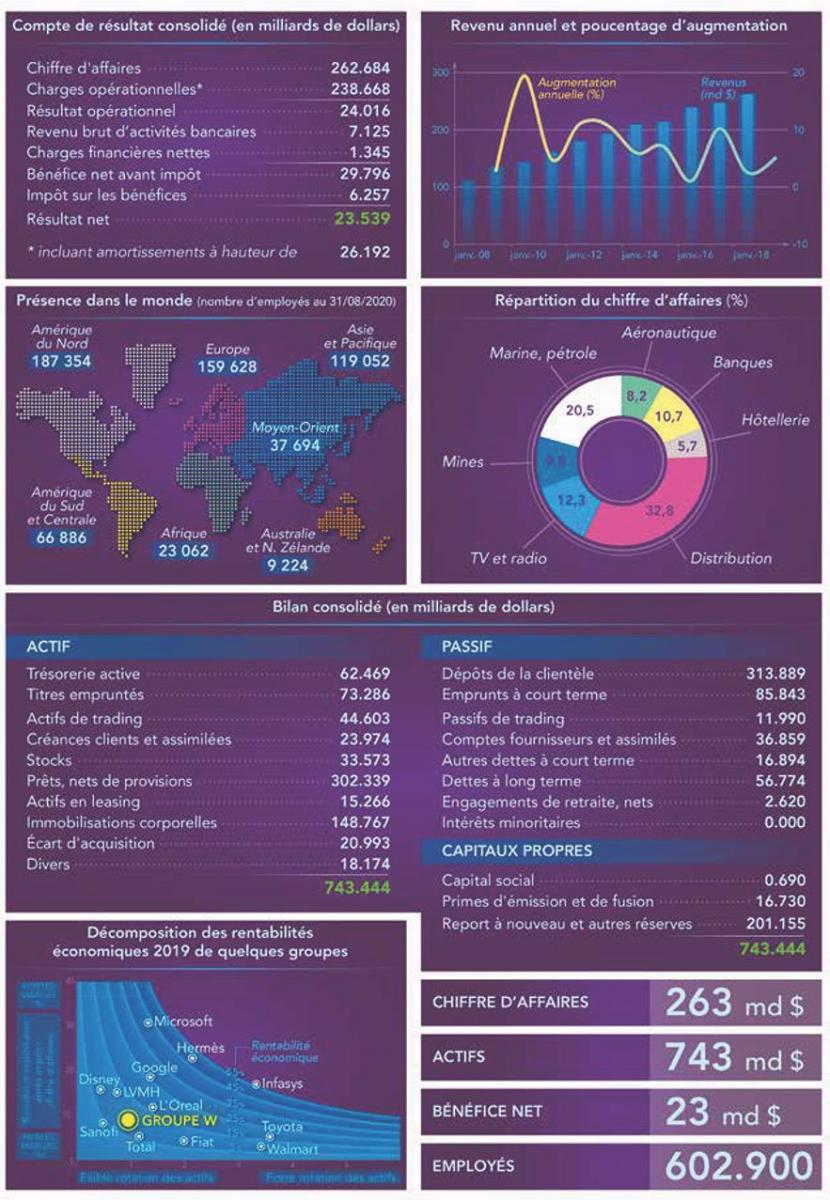
THE ECONOMIC FACTSHEETS (download)
The Largo Winch series examines the modern-day economy from a human perspective, through a character who is a bit of an idealistic "boy scout", with this paradox: when you inherit an industrial and financial fortune, what perception can you truly have of social reality? How do you view fairness? Justice?
How can you change events and, crucially, to what end?
What hopes and goals can an ultra-high-net-worth individual have apart from living off their private income?
And last but not least, does a rich man deserve to be happy? Is a company manager with a host of responsibilities allowed to have a taste for adventure?
The exhibition sets out to answer these questions in chronological order.
Download our factsheets which unpack the ins and outs of economics in Largo’s world.
THE AUTHORS
PHILIPPE FRANCQ
In just a few albums, Philippe Francq carved a reputation out for himself as one of the greatest realistic illustrators of his generation. He studied at Brussels’ Institut Saint-Luc in the graphic design section before joining the comic book studio run by Claude Renard, François Schuiten and Philippe Berthet. He then honed his skills at the Hergé studio with Bob de Moor. Heeding the advice of the best Belgian realistic illustrator of his time, Hermann, with Bob de Groot writing the script he published two albums for the series Des Villes et des Femmes (1987) followed by another two for the Léo Tomasini series (1988) with Francis Delvaux. A meeting with Jean Van Hamme in 1989 saw the latter ask him to illustrate Largo Winch.
His draughtsmanship is in the tradition of the Belgian school and that of Hergé: precise, perfectly executed in the attitudes of the characters, fabric folds and drapery, architecture, cars, boats, aircraft... And jet-set scenes. It is very carefully documented, each album being subject to location research, often shored up by a reporting assignment at the site where the adventure is taking place, where Philippe Francq takes thousands of photos. At times, Jean Van Hamme has given him pictures that he had personally taken during his travels When it’s time to put pencil to paper, the first stage involves sketching the scene, laying out what it will look like, as clearly and fluidly as possible; then comes the inking stage which, since the 15th album, has been done on a graphics tablet, which sets the drawing in stone as it were. The final stage involves adding colour, “when light fills the picture”.
Over 30 years, just like Hergé’s Tintin back in the day, he has described the era (computers, mobile phones, architecture, etc.). “Details make perfection, and perfection is not a detail…" In Largo Winch’s adventures, Philippe Francq has truly made this aphorism of Leonardo da Vinci his own, with each scene retaining its truth and emotion thanks to a drawing that is a masterpiece of perfection. The exhibition displays more than 40 outstanding original illustrations.
ÉRIC GIACOMETTI
Éric Giacometti was an investigative journalist before becoming deputy editor of the "society” then “economics/finance” sections in the leading national daily newspaper Le Parisien / Aujourd’hui en France. In 2005, he teamed up with his friend Jacques Ravenne to create the successful thriller about the freemason cop Antoine Marcas (published by Jean-Claude Lattès), a series that has been translated in 18 countries and has sold nearly three million copies. He produced a graphic novel version of it with illustrations by Gabriele Parma and then by Éric Albert (published by Delcourt).
In 2016, his longtime friend Philippe Francq asked if he wanted to take over the writing for Largo Winch after Jean Van Hamme decided to stop. What a challenge! But thanks to his experience as a novelist, he was able to analyse the Largo albums “with a professional eye”. The series was initially set against the economic backdrop coming out of World War II. He therefore set himself the task of ushering it into a new era. For him, Largo Winch, the recalcitrant billionaire, is Spartacus who becomes Caesar.
On 6 May 2010, while still a journalist for the economics section of Le Parisien, Éric personally witnessed the flash crash of the New York stock exchange, caused by high-frequency trading, and he drew inspiration from this for l’Étoile du matin.
Published on 07 October 2020. Updated on 18 May 2021
Would you like to earn more to be able to buy more? But to what extent does a higher income enable us to really increase our standard of living? Be careful not to fall into the trap of the money illusion!
Purchasing power is the amount of goods and services that can be bought with our income.
Increasing incomes therefore makes it possible to increase purchasing power. But beware that this is not necessarily enough, as changes in the general price levels must also be taken into account…
Let’s have a look, for example, at the growth in purchasing power between 1973 and 2008, when three periods unfolded in succession: a period of high inflation until 1984, followed by a period of disinflation until 1996 and finally a period of low inflation until 2008.
Which period coincided with a higher increase in purchasing power for French citizens? Let’s check with our "Price stability and purchasing power” challenge!
Duration: 2’
Languages: French, English, Spanish
Who can play: everyone
Design: Banque de France / Cité de l’Économie
Production: Opixido
Published on 16 August 2022. Updated on 13 June 2024
Pensions are something we hear about a lot! But how are they financed? Let’s have a closer look and play around with the 3 parameters that influence its financial stability.
In France, pensions operate according to a so-called "pay-as-you-go" system, which means that the contributions paid by employers and employees go towards the financing of retired people’s pensions.
But in this kind of system, when the average age of the population rises (as has been the case in France for a number of years now), the number of pensioners rises faster than the number of contributors. This leads to a problem in terms of the financial stability of the pension system, which can be adjusted by changing its three key parameters: the State pension (i.e. retirement) age, the contribution rates and the pension levels.
Let’s fast-forward to the year 2070, and imagine that the system is stable: let’s see what would happen to the pension level if we were to change the State pension age and contribution rate. The decisions are in your hands!
Duration: 7’
Languages: French, English, Spanish
Who can play: everyone
Design: Banque de France / Cité de l’Économie
Production: Opixido
Published on 16 August 2022. Updated on 18 November 2020
The Governor of the Banque de France, Chairman of Citéco, has appointed Emmanuel Constans as Deputy Chairman of Citéco.
Honorary General Inspector of Finances, Emmanuel Constans was until 2016 the Ombudsman of the Ministry of the Economy and Finance.
He chaired the Comité consultatif du secteur financier (CCSF) from 2004 to 2017.
He is a member of the Autorité de contrôle prudentiel et de résolution (ACPR) which oversees the activities of banks and insurance companies.
He chairs the mediation committee and the monitoring and proposals committee of the AERAS agreement (s’Assurer et Emprunter avec un Risque Aggravé de Santé).
Published on 18 December 2017. Updated on 12 May 2025
In order to prepare its opening to the public at the begenning of 2019, the association that will be in charge of operating the Cité de l’économie et de la monnaie (Citéco) is taking shape with the appointment and arrival of its Director Philippe Gineste.
Philippe Gineste, a trained historian, has an experience of over 20 years in the management of cultural institutions. He was the Director of the Parc aux étoiles in the Yvelines from 2003 to 2011 and Director of the Vaisseau in Strasbourg from 2011 to 2017. Thanks to these experiences, he has acquired a strong expertise in the management of interactive, educational and cultural institutions. He emphasises the role of games as a driving force for learning, with the public at the heart of the educational approach.
With the arrival of Philippe Gineste, the opening of Citéco is coming into focus. It is expected to welcome its first testing visitors at the end of 2018 and the beginning of 2019.
Question to Philippe Gineste: why did you choose Citéco?
"It’s the story of an encounter. An encounter between a remarkable project in a building of great architectural quality, and my career path which is marked by my commitment to scientific culture and the transmission of knowledge. With Citéco, we have the opportunity of setting up an institution that puts the economy, even more so than today, within the cultural and educational realm of the public. As a place for encounters, discoveries, games and exchanges, which also showcases splendid collections, this interactive museum aims to offer a unique visitor experience. It’s a wonderful challenge that I could only accept."
Photo credit : © Jonathan Sorago
Published on 06 December 2017. Updated on 12 May 2025
Can we depict work? From 24 April to 4 June 2017 took place the second biennial festival of Usimages. Usimages is an exhibition of industrial photography organised by the urban community of Creil and by the photography centre of Picardie, Diaphane.
The festival covered a number of areas: people in the workplace, people’s relationship with machines, the representation of industry in the history of photography, traces of the industrial heritage in the landscape, industrial architecture, and works of art ordered by companies to artists.
Usimages 2017 included ten photography exhibits from archives and contemporary artists, practical photography workshops, guided tours, a cycle of lectures, and an initiative for the inhabitants of Creil to collect photos taken in the workplace. The 2017 Usimages prize was awarded to the best photo taken in the workplace in 2015 or 2016.
In the exhibition, visitors could discover EDF power plants, experimental laboratories for new robots, the self-representation of company employees, the world of carpentry, the working time of employees in the petrochemical sector, the creation of the RER, etc.
What uses can be made of workplace photos?
Usimages invites reflection on the uses of workplace photography: a means of information on economic and social development, a denunciation of difficult working conditions, a tool for companies to show their know-how, performances, etc.
An educational pack was given to teachers to prepare the visits.
For further information: Usimages 2017
Click on the following links for our articles about the representation of the economy in photos: Progrès ou déclin en photos, Photographie-moi la confiance, the analysis of our educational project: Photographier l’économie and bibliographie « L’économie en images ».
Published on 14 March 2017. Updated on 13 June 2024
The National Committee for Financial Education met for the first time on 20 December 2016. It launched the national financial education strategy to enable everyone to acquire greater fluency in financial matters and thereby reduce the inequalities in this area.
The main features of the strategy are the following.
- It draws on the recommendations and principles laid down by the OECD and the G20.
- It is also part of the national plan for combating poverty and fostering social inclusion, launched in 2013.
- It is based on the analysis and proposals put forward by the Comité consultatif du secteur financier (Advisory Committee on the Financial Sector – CCSF) in its 2015 report.
- It is aimed at a wide audience and especially young people and people in financial difficulty.
- The strategy federates the actions of the various players already involved: public authorities (Ministries of the Economy and Finance, Education, Agriculture, Social Affairs, the Banque de France, the Autorité des marchés financiers), financial sector professionals, associations for consumer protection and the fight against exclusion, etc.
- The role of operator for the implementation of the strategy has been entrusted to the Banque de France, which is already charged with processing cases of over-indebtedness and informing the public on issues linked to bank accessibility. It has signed agreements with a large number of education authorities. It has launched, in the field of economic education, the project of the Cité de l’économie et de la monnaie and the citeco.fr website. As operator of the financial education strategy, the Banque de France will act in close liaison with the various players concerned, in particular with two Citéco partners: the Ministry of Education and the Institut pour l’éducation financière du public (“La finance pour tous”).
- In early 2017, the dedicated web portal “Mes questions d’argent” will be put online, ensuring the widespread dissemination of financial education products and establishing a link to the sites of the different players.
- In the second quarter of 2017, emphasis will be placed on the provision of educational resources for social workers.
- In the second half of 2017, information kits, drawn up in partnership with the Ministries of the Education and Agriculture, will be made available to teachers.
For more information on the national strategy, and to see the CCSF report and the video of the press conference of 20 December 2016, click here.
Published on 21 December 2016. Updated on 20 February 2024
